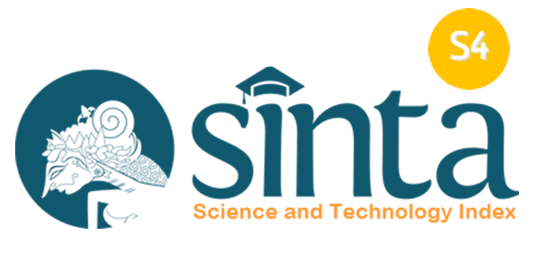Model Construction untuk Meningkatkan Kemampuan Cognitive Mapping Anak Tunanetra
Abstract
Cognitive mapping terhadap suatu ruang merupakan hal yang penting untuk pengembangan keterampilan orientasi dan mobilitas yang efisien. Salah satu media yang dapat membantu seorang tunanetra dalam mengenali lingkungan adalah model. Dalam penelitian ini suatu model construction diajarkan pada anak dalam beberapa tahapan. Masalah utama penelitian ini adalah: Apakah model construction dapat meningkatkan kemampuan cognitive mapping anak tunanetra? Penelitian ini dilakukan pada tiga orang siswa tunanetra di tingkat SD dengan dengan usia antara 9-10 tahun. Dua orang subjek merupakan anak dengan tunanetra total dan satu orang subjek anak dengan low vision. Hasil penelitian menunjukkan bahwa skor ketepatan arah meningkat, begitu pula dalam tugas perkiraan jarak. Adanya peningkatan ini mengindikasikan bahwa penggunaan metode model construction dapat meningkatkan kemampuan cognitive mapping anak tunanetra.
Kata kunci: cognitive mapping, model construction, tunanetra
Keywords
Full Text:
PDFReferences
Casey, S. (1978) Cognitive mapping by the blind. Journal of Visual Impairment and Blindness, 72, 297-301.
Daryanto. 2010. Media Pembelajaran. Bandung. PT.Sarana Tutorial Nurani Sejahtera
Dodds, A. G., Howart, C. I., & Carter, D., C. (1982). The Mental Maps Of Theblind: The Role Of Previous Experience. Journal Of Visual Impairment & Blindness, 76, 5-12.
Duquette, J. (2012). Spatial orientation in adolescents with visual impairment: related factors and avenues for assessment. Institute Nazareth & Louise Braille.
Espinosa, M.A. & Ochaita, E. (1998).Using Tactile Maps to Improve the Practical Spatial Knowledge of Adults Who Are Blind. American Foundation for the Blind. All rights reserved. Journal of Visual Impairment and Blindness, May 1998, pp.338-345.
Fauziah, N. (2013). Penggunaan Media Miniatur Dalam Model Pembelajaran Berdasarkan Masalah Pada Materi Gaya Dan Momen Di Kelas X Tgb 3 Smk Negeri 3 Surabaya. Prodi Studi Pendidikan Teknik Bangunan, Fakultas Teknik, Universitas Negeri Surabaya.
Fletcher, J. (1980) ‘Spatial Representation In Blind Children 1: Development Compared To Sighted Children.’ Journal Of Visual Impairment And Blindness, 74 (10), Pp. 318–85.
Foulke, E. & Hatlen, P.H. (1992). A Collaboration Of Two Technologies. Part 1: Perceptual And Cognitive Processes: Their Implications For Visually Impaired Persons. British Journal Of Visual Impairment, 10, 43-46.
Hupp, G. S. (2003). Cognitive Differences Between Congenitally Blind and Adventitiously Blind. (Online). Tersedia: httpdigital.library.unt.edu
Hallahan, P., D. & Kauffman, M., J. (2006). Exceptional Learners: introduction to special education. Boston: Pearson Education, Inc.
Jacobson, R., D. (1998). Cognitive Mapping Without Sight: Four Preliminary Studies Of Spatial Learning. Journal of Environmental Psychology. 18, 289-305.
Jacobson, R. D. (1992). Spatial cognition through tactile mapping. Swansea Geographer 29, 79-88.
Kitchin, R. M. & Jacobson, R. D. (1997). Techniques to collect and analyse the cognitive map knowledge of people with visual impairments or blindness. Journal of Visual Impairment and Blindness 91, 360-376.
Lahav, O & Mioduser, D. (2003). A blind person’s cognitive mapping of new spaces using a haptic virtual environment. Journal of Research in Special Educational Need, 3,172–177
Lewis, V. (2003). Development and Disability. United Kingdom: Blackwell Publishing.
Munadi, . 2008. Media pembelajaran. Jakarta: PT.Gaung Persada Press.
Ormod, J. E. (2008). Studying Cognitive Phenomena With Behaviorist Techniques: Tolman’s Work. Upper Saddle River, NJ: Merrill/Prentice Hall.
Predrag, S. (2007). On Lycnh And Post Lynchian Theory. Architecture and Civil Engineering Vol. 5, No 1, pp. 61 – 69
Reiser, J.J (1990). Mental Processes Mediating Independent Travel: Implication for Orientation and Mobility. Journal of Visual Impairment and Blindness 76 (6), 213-218.
Rohman, Muhammad dan Amri, S. 2013. Strategidan desain Pengembangan Sistem pembelajaran. Jakarta: PT. Prestasi Pustakaraya.
Sanchez, J. & Jorquera, L. (2000). Interactive Virtual Environment for Blind Children: Usability and Cognition. V Congreso Iberoamericano De Informatica Educativa
Schinazi, V. R. (2005). Spatial representation and low vision: Two studies on the content, accuracy and utility of mental representations. UK: International Congress Series 1282 (2005) 1063–1067
Scholl, T. G.(1986). Foundations of Education for Blind and visually handicapped children and youth. New York: American Foundation for the blind, inc.
Smith, D. D. (2006). Introduction To Special Education: Teachingin An Age Of Opportunity.
Stakes, Robert E. (2006) Qualitative Case Study. In Norman K. Denzin & Yvonna S. Lincoln (Eds.), Handbook Of Qualitative Research. Thhousand Oaks, CA: Sage Pub
Sugiyono (2011). Metode Penelitian Kuantitatif, Kualitatif, dan R & D. Bandung: Alfabeta
Tarsidi, D. (2007). Dampak Ketunanetraan terhadap Keterampilan Mobilitas Anak. (Online). Tersedia di: http://www.d-tarsidi.blogspot.com. Diakses pada tanggal 01 Januari 2015
Tolman, E. C. (1948). Cognitive maps in rats and men. Psychological Review, 55,189-208
Ubaidillah, I. (2014). Media Pembelajaran Sejarah. (Online) Tersedia di: http://iqbalubaidillah1101.blogspot.com/2014/12/media-pembelajaran-sejarahmodel.html. Diakses pada tanggal: 01 Januari 2015
Ungar, S. (1996). Construction of Cognitive Maps. Dordrecht: Kluwer Academic Publishing.
Von Senden, S.M. (1932). Space and Sight: the Perception of Space and Shape in the Congenitally Blind Before and After Operation. Glencoe, IL: Free Press.
Warren, H., David. (2003). Blindness and children: an individuaal differences approach. Cambridge: Cambridge University Press
Worchel, P. (1951). Space Perception and Orientation in the blind. Psychological Monograph, 65
DOI: https://doi.org/10.17509/jassi.v16i2.5754
Refbacks
- There are currently no refbacks.
Copyright (c) 2017 Universitas Pendidikan Indonesia

This work is licensed under a Creative Commons Attribution-ShareAlike 4.0 International License.




